PEP小学英语六年级上册(全英)教案
Pep六上英语教案6篇
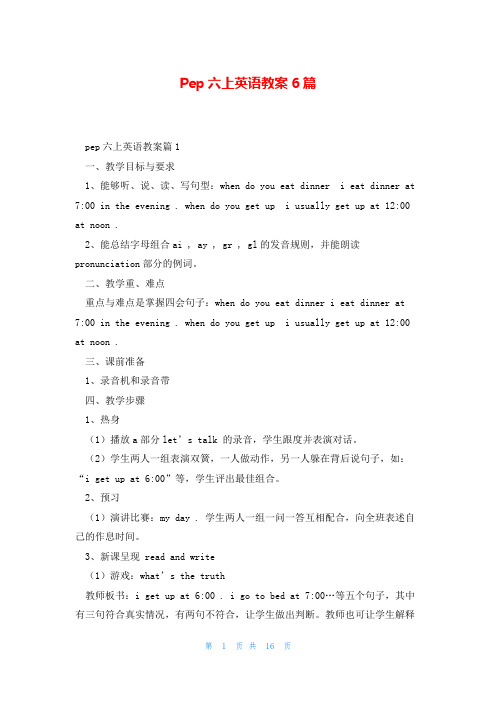
Pep六上英语教案6篇pep六上英语教案篇1一、教学目标与要求1、能够听、说、读、写句型:when do you eat dinner i eat dinner at 7:00 in the evening . when do you get up i usually get up at 12:00 at noon .2、能总结字母组合ai , ay , gr , gl的发音规则,并能朗读pronunciation部分的例词。
二、教学重、难点重点与难点是掌握四会句子:when do you eat dinner i eat dinner at 7:00 in the evening . when do you get up i usually get up at 12:00 at noon .三、课前准备1、录音机和录音带四、教学步骤1、热身(1)播放a部分let’s talk 的录音,学生跟度并表演对话。
(2)学生两人一组表演双簧,一人做动作,另一人躲在背后说句子,如:“i get up at 6:00”等,学生评出最佳组合。
2、预习(1)演讲比赛:my day . 学生两人一组一问一答互相配合,向全班表述自己的作息时间。
3、新课呈现 read and write(1)游戏:what’s the truth教师板书:i get up at 6:00 . i go to bed at 7:00…等五个句子,其中有三句符合真实情况,有两句不符合,让学生做出判断。
教师也可让学生解释判断的依据。
(2)上一活动结束时,教师说:you’re right . i don’t go to bed so late . i go to bed before 11:00 , but some people really go to bed at 7:00 in the morning . do you know why who are they let’s go and see .(3)教师播放本部分的录音,让学生听录音,看对话。
PEP小学英语六年级上册全册教案
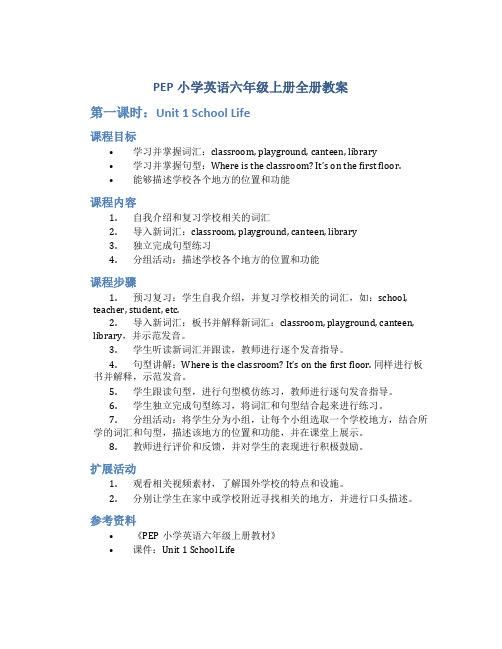
PEP小学英语六年级上册全册教案第一课时:Unit 1 School Life课程目标•学习并掌握词汇:classroom, playground, canteen, library•学习并掌握句型:Where is the classroom? It’s on the first floor.•能够描述学校各个地方的位置和功能课程内容1.自我介绍和复习学校相关的词汇2.导入新词汇:classroom, playground, canteen, library3.独立完成句型练习4.分组活动:描述学校各个地方的位置和功能课程步骤1.预习复习:学生自我介绍,并复习学校相关的词汇,如:school, teacher, student, etc.2.导入新词汇:板书并解释新词汇:classroom, playground, canteen, library,并示范发音。
3.学生听读新词汇并跟读,教师进行逐个发音指导。
4.句型讲解:Where is the classroom? It’s on the first floor. 同样进行板书并解释,示范发音。
5.学生跟读句型,进行句型模仿练习,教师进行逐句发音指导。
6.学生独立完成句型练习,将词汇和句型结合起来进行练习。
7.分组活动:将学生分为小组,让每个小组选取一个学校地方,结合所学的词汇和句型,描述该地方的位置和功能,并在课堂上展示。
8.教师进行评价和反馈,并对学生的表现进行积极鼓励。
扩展活动1.观看相关视频素材,了解国外学校的特点和设施。
2.分别让学生在家中或学校附近寻找相关的地方,并进行口头描述。
参考资料•《PEP小学英语六年级上册教材》•课件:Unit 1 School Life第二课时:Unit 2 Family课程目标•学习并掌握词汇:father, mother, sister, brother, grandparents•学习并掌握句型:This is my father. These are my grandparents.•能够介绍自己的家庭成员课程内容1.导入新词汇:father, mother, sister, brother, grandparents2.独立完成句型练习3.分组活动:介绍自己的家庭成员课程步骤1.导入新词汇:板书并解释新词汇:father, mother, sister, brother, grandparents,并示范发音。
pep六年级上册英语教案
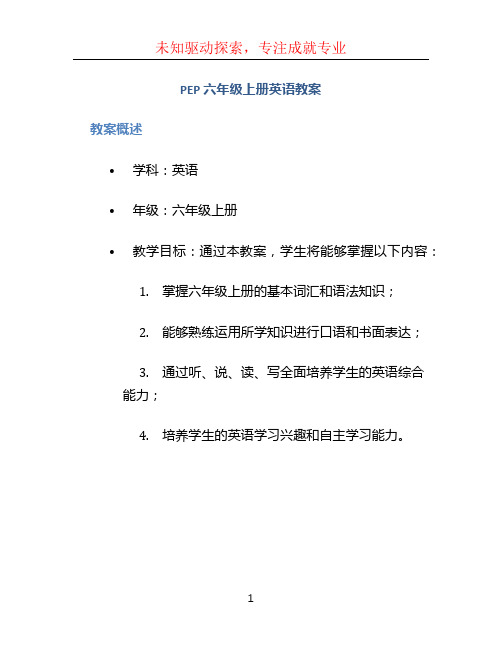
PEP 六年级上册英语教案教案概述•学科:英语•年级:六年级上册•教学目标:通过本教案,学生将能够掌握以下内容:1.掌握六年级上册的基本词汇和语法知识;2.能够熟练运用所学知识进行口语和书面表达;3.通过听、说、读、写全面培养学生的英语综合能力;4.培养学生的英语学习兴趣和自主学习能力。
教学内容和教学步骤Unit 1: My Family课时 1•课时目标:通过介绍家庭成员和描述人物特征,学生能够熟练掌握家庭成员的英文表达。
•教学重点:–学习并掌握家庭成员的英文表达;–学习并运用形容词描述人物特征。
活动一:Warm-up(15分钟)•教师与学生互动,介绍自己的家庭成员,并使用英文进行描述,引起学生的兴趣。
活动二:Presentation(30分钟)1.教师出示图片,介绍不同的家庭成员,如爸爸、妈妈、哥哥、姐姐等,并让学生跟读并模仿发音。
2.教师示范使用形容词描述人物特征,如tall(高个子)、short(矮个子),并让学生模仿。
活动三:Practice(25分钟)1.学生和教师进行对话练习,描述家庭成员的特征。
2.学生互相配对,通过描述对方的家庭成员,练习运用所学知识。
活动四:Consolidation(10分钟)1.教师用图片进行复习,并让学生回答问题,巩固所学知识。
2.课堂小结,师生共同总结本节课所学内容。
课时 2•课时目标:通过学习家庭成员的日常活动,学生能够运用所学知识描述家庭成员的日常生活。
•教学重点:–学习并掌握家庭成员的日常活动的英文表达;–运用所学知识进行日常生活场景的对话和表演。
活动一:Warm-up(15分钟)•教师通过幻灯片展示不同的家庭成员进行日常活动,并引导学生进行朗读和模仿。
活动二:Presentation(30分钟)1.教师出示不同的家庭成员在日常生活中的活动图片,并进行介绍和讲解,引导学生理解活动内容和相关词汇。
2.教师介绍日常活动的时间状语,如in the morning (早上)、in the afternoon(下午),并让学生跟读和模仿。
PEP版小学英语六年级上册全册教案

PEP版小学英语六年级上册全册教案The first period(第一课时)Part A Let' s try & Let's talk内容分析本课是PEP小学英语六年级第一册Unit1第一课时。
主要学习能够理解和掌握本课时的重点词汇和句型以及能够在情景中恰当运用句型“—Where is the…? —It's…”询问地点并作答。
老师将通过多种游戏活动巩固重点单词和句型,使学生掌握本节课知识点。
课时目标知识与能力·能够读懂题目要求,对听力的重点内容进行预测·通过听录音,运用基本的听力技巧,勾选正确的选项·通过观察、谈论Let's talk板块的图片,在PPT和老师的帮助下理解对话大意,并能够回答对话下面的问题·通过听录音,能够用正确的意群及语音、语调朗读对话,并能在小组中进行角色表演·能够在情景中恰当运用句型“—Where is the…? —It's…”询问地点并作答·能够在语境中借助图片等帮助理解新词“museum, bookstore, post office, ask, sir”的意思,并能够正确发音·能够运用礼貌用语寻求他人的帮助过程与方法利用机器人创设情境,通过各种不同功能的机器人,激发学生学习兴趣,吸引其注意力。
先引导学生基于语言情境猜测吴一凡所在的场所,再通过听力验证预测的答案并完成Let's try 板块的听力练习,培养学生听前预测的习惯。
情感态度价值观引导学生在小组中相互交流居住地的相关城市设施和位置,拓展学生对自己兴趣爱好和经常活动的表达,提高学生的语言综合运用能力。
教学重难点教学重点能够理解和掌握本节课的重点单词和句型。
教学难点能够在情景中恰当运用句型“—Where is the…? —It's…”询问地点并作答。
教学准备PPT课件、课文录音、视频等。
PEP小学英语六年级上册全册教案完整版
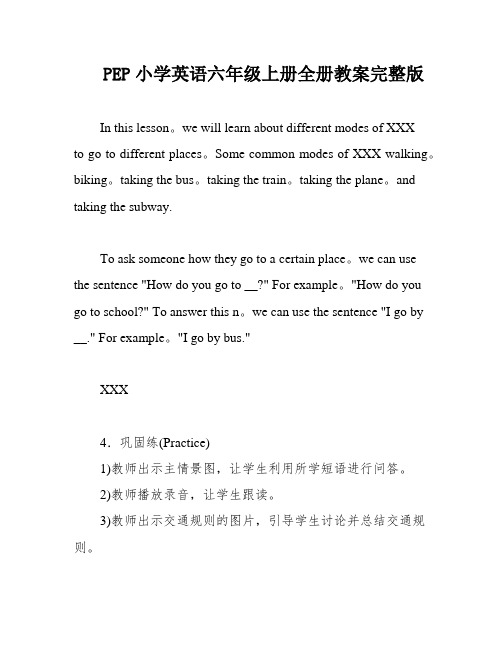
PEP小学英语六年级上册全册教案完整版In this lesson。
we will learn about different modes of XXXto go to different places。
Some common modes of XXX walking。
biking。
taking the bus。
taking the train。
taking the plane。
and taking the subway.To ask someone how they go to a certain place。
we can use the sentence "How do you go to __?" For example。
"How do you go to school?" To answer this n。
we can use the sentence "I go by __." For example。
"I go by bus."XXX4.巩固练(Practice)1)教师出示主情景图,让学生利用所学短语进行问答。
2)教师播放录音,让学生跟读。
3)教师出示交通规则的图片,引导学生讨论并总结交通规则。
5.课堂小结(Summary)本课我们研究了不同的交通方式,学会了如何用英语问别人如何去某个地方,以及如何回答这个问题。
同时,我们也研究了交通规则并了解了交通安全的重要性。
6.课后作业(Homework)1)完成Let'slearn部分的练。
2)写一篇短文介绍自己通常怎样去学校或其他地方。
注:本教案可根据实际情况进行适当调整。
1.教师可以通过自问自答的方式来引导学生研究交通方式的表达。
例如,教师可以问:“How do I go to school。
I go to school by bike.” 然后在黑板上写下“by bike”,并帮助学生说出完整的句子“ I go to school by…” 并将相应的短语写在黑板上。
新版PEP小学六年级上册英语全册教案
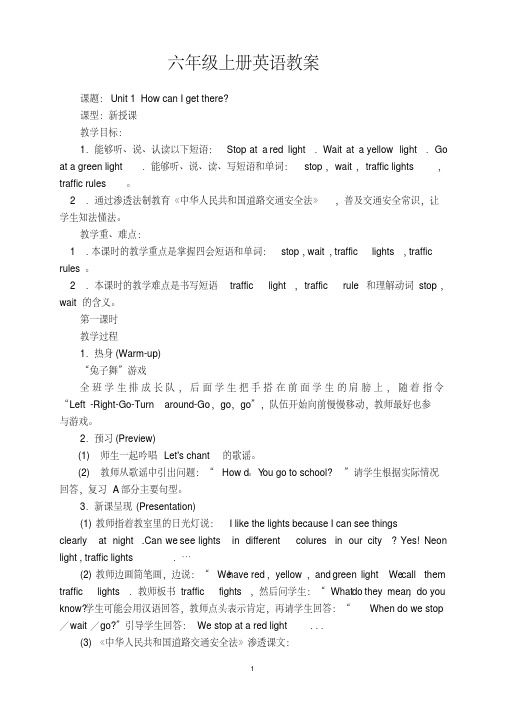
六年级上册英语教案课题:Unit 1 How can I get there?课型:新授课教学目标:1.能够听、说、认读以下短语:Stop at a red light.Wait at a yellow light.Go at a green light.能够听、说、读、写短语和单词:stop,wait,traffic lights,traffic rules。
2.通过渗透法制教育《中华人民共和国道路交通安全法》,普及交通安全常识,让学生知法懂法。
教学重、难点:1.本课时的教学重点是掌握四会短语和单词:stop,wait,traffic lights,traffic rules。
2.本课时的教学难点是书写短语traffic light,traffic rule和理解动词stop,wait的含义。
第一课时教学过程1.热身(Warm-up)“兔子舞”游戏全班学生排成长队,后面学生把手搭在前面学生的肩膀上,随着指令“Left-Right-Go-Turn around-Go,go,go”,队伍开始向前慢慢移动,教师最好也参与游戏。
2.预习(Preview)(1)师生一起吟唱Let's chant的歌谣。
(2)教师从歌谣中引出问题:“How d。
Y ou go to school?”请学生根据实际情况回答,复习A部分主要句型。
3.新课呈现(Presentation)(1)教师指着教室里的日光灯说:I like the lights because I can see thingsclearly at night .Can we see lights in different colures in our city ? Yes! Neon light , traffic lights.…(2)教师边画简笔画,边说:“We have red,yellow,and green light We call them traffic lights.教师板书traffic fights,然后问学生:“What do they mean,do you know?学生可能会用汉语回答,教师点头表示肯定,再请学生回答:“When do we stop /wait/go?”引导学生回答:We stop at a red light...(3)《中华人民共和国道路交通安全法》渗透课文:《中华人民共和国道路交通安全法》第二十六条交通信号灯由红灯、绿灯、黄灯组成。
pep小学六年级英语上册全册教案

pep小学六年级英语上册全册教案《PEP小学六年级英语上册全册教案》第一单元:Hello!教学目标:1. 能够听懂并正确模仿老师的问候语和自我介绍。
2. 能够正确朗读并书写单词hello、hi。
3. 能够在日常生活中灵活应用问候语,与他人进行简单交流。
课程安排:第一课:Hello!- 介绍问候语hello和hi,学生模仿老师的发音。
- 练习问候,学生之间互相问候并回答。
- 小组活动:四人一组,每人向其他三人问好并回答。
第二课:What's your name?- 介绍自我介绍的句型"What's your name?" "My name is ____." - 学生自我介绍,使用所学句型。
- 小组活动:学生两两进行自我介绍。
第三课:Nice to meet you!- 介绍句型"Nice to meet you!",学生模仿老师的发音。
- 学生之间进行简单对话,使用问候语和自我介绍句型。
- 小组活动:学生模拟真实场景,进行问候和自我介绍。
第四课:Goodbye!- 学习单词goodbye,并模仿老师的发音。
- 学习道别语句"Goodbye!",学生模仿老师的发音。
- 学生之间进行简单对话,使用问候语、自我介绍和道别语句。
- 小组活动:学生两两进行问候、自我介绍和道别。
第五课:Review- 复习本单元所学内容,对话练习。
- 小组活动:学生进行自由对话,运用本单元所学内容。
教学反思:通过本单元的学习,学生初步掌握英语问候语、自我介绍和道别语句的基本用法。
教师利用对话、模仿、角色扮演等多种教学方法,提高学生的参与度和实际运用能力。
小组活动的设置使学生能够在情景中灵活应用所学知识,增加学习的趣味性和成效。
同时,教师还要注重学生的发音和书写,引导学生正音正写,提高语言表达的准确性。
通过本单元的学习,学生将增强英语的学习兴趣,为下一个单元的学习打下良好基础。
PEP六年级上册英语全册教案

Unit 1 How Do Y ou Go There?单元教学目标1、能力目标(1)能够结合学过的语言通过询问了解他人描述用何种方式进行日常活动的及基本情况,同时能正确表述本人或他人开展活动的基本状况。
(2)围绕主题“How do you go there?”展开一系列的话题,鼓励学生自编自演以身边生活为大背景的故事。
(3)能唱歌曲How do you go to school?2、知识目标(1)能够正确询问并回答乘做某种交通工具去某地,如:How do you go to school? Usually I go to school by bike. Sometimes I go on foot. How can I get to Zhongshan Park?Y ou can go by the No.15 bus.(2)能够描述人们日常出行的方式,并简单陈述理由。
(3)能够听、说、认读A、B部分Let’s learn中的三会单词和Let’s talk,Let’s read 中出现的三会句型。
(4)能够了解不同国家交通规则的异同。
(5)了解音标/i:/, /i/,/p/,/b/,/t/,/d/的音和形;能够区分音标/i:/和/i/发音不同。
3、情感、策略、文化等有关目标(1)情感态度:帮助学生了解交通规则,并在生活中自觉遵守交通规则。
(2)学习策略:学会调查和统计、分析数据,并用扇形统计图的形式表示出来。
(3)文化目标:了解中西方交通规则的异同。
单元内容分析:本单元重点学习如何询问和回答人们日常出行的方式。
这个话题与学生的日常紧密联系。
第一单元How do you go there? 本单元重点是学习如何询问和回答人们日常出行的方式,这个话题与学生的日常生活紧密联系。
本单元的难点是学生能够熟练使用所学语言询问并回答乘坐某种交通工具去某地。
下面我以一单元Part A Let’s read为例来谈一谈我的教学设计。
- 1、下载文档前请自行甄别文档内容的完整性,平台不提供额外的编辑、内容补充、找答案等附加服务。
- 2、"仅部分预览"的文档,不可在线预览部分如存在完整性等问题,可反馈申请退款(可完整预览的文档不适用该条件!)。
- 3、如文档侵犯您的权益,请联系客服反馈,我们会尽快为您处理(人工客服工作时间:9:00-18:30)。
Unit 1 How do you go there?Period OneTeaching contents: Part A let’s learn & let’s playTeaching aims:1.To enable the students to master the four skills phrases: on foot,by bike,by bus,by train, by plane,by ship,by subway2.To enable the students to ask about the ways of traffic with the following sentence patterns: How do you go to school? Or How do you go toCanada…?”And answer with“I go by…”Teaching focus:To master the four skills phrases: by train, by plane, by subway, by ship, by bike, on footTeaching difficulty:To differ “subway” from“train”Teaching methods:Communicative ApproachTeaching aids:1.Word cards2.Tape recorder and tape3.Multi-media playerTeaching procedure:1. (Warm-up)Greeting: Good morning , class !Glad to meet you again. How are you?What day is it? What ‘s the date?What’s the weather like today?2. PresentationShow a picture of busT: What’s this? S: It’s a bus.T: I go to school by bus. How do you go to school?(Show a picture of bike and help a student to answer with “I go to school bybike.”)(In the same ways)Teach “by subway” and “by train” “by ship” “by plane” “onfoot”.Subway: It's an underground railway in a city.It travels very fast.We can see subway in Hong Kong, Beijing, Shanghai, Gongzhou…Explain the differences between subway and trainPay attention to the pre. “ by”& “on”3.Play gamesAsk one S to the front and stick the word cards next to the phrases written on the Bb when T read the new phrases quickly and the other Ss put up their cards. The one who reflect fastest and correctly is the winner.4.Listen to the tape of Part A Let’s learn and follow it.Pay attention to the tone and pronunciation5.Practice: Let’s playT Offer many places (the USA. England Australia Hong Kong ShanghaiGuangzhou the moon…) and traffic ways (by car/ taxi/ bus… on foot)Ss practice with above places and ways in pairs:A: How do you go to school?B: I go to school on foot.Encourage the Ss to make up as many sentences as they can.6.Spelling competitionDivide the class into tow groups. Show the pictures of traffic tools and ask Ss to spell the phrases. The first one who puts up hand gets the chance to spell. The group spell out more phrases are the winners.HomeworkCopy the new words and phrasesFinish Page1 of the ABBb design:Unit One How do you go there?How do you go to school/ Canada?I go to school on foot/ by subway/ bus/ train/ taxi…Teaching reflection:Unit1 How do you go there?Period TwoTeaching contents: Let’s try & let’s talkTeaching aims:1.To master the four skills sentence: “How do you go to school? Usually I go toschool on foot.Sometimes I go by bike.”2.To enable the Ss to ask and answer about traffic ways and explain the simplereason why he or she chose this traffic way.I go to school on foot, because my home is near.3.To make the Ss understand the listening material in “Let’s try”情感目的Teaching focus:文中的新句子To use and write the following key sentences:How do you go to school?Usually I go to school by bike. Sometimes I go on foot.Teaching difficult points:To write the key sentences: How do you go to school?Usually I go to school on foot.Sometimes I go by bike.To use Adverbs of frequency: usually, sometimesTeaching aids:Tape recorder Teaching cards a piece of paperTeaching procedure:1. (Warm-up)T: Good morning! How do you go to school today? What about you? Do you go by bus,too?”2. Have a dictationAsk the Ss to dictate the new words learnt in the last lesson.On foot、by bus、by train、by plane、by subway…3. Let'stryGuide the Ss to look at the pictures and askWho’s the boy? He’s Mike.How does Mike go to school?Play the tape and listen:John:How do you go to school,Mike?Mike:I usually go to school by bike.Sometimes I go 0n foot.John:Is your home near our school?Mike:Yes.it is.J0hn:That's fine!4. (Presentation)Let's talkT: How do I go to school,do you know? Ask me,please!Draw a bike, a bus, a taxi on the Bb and write the price by each picture. Bus 1 yuan taxi 10 yuanEncourage the Ss to ask “How do you go to school?T: Usually I go to school by bike, because it's good exercise.Sometimes I go by bus,because it's cheap.It costs l yuan. Sometimes I go by taxi,because it'sfast,but it's too expensive.It costs 1o yuan.Explain that we use usually and sometimes to express frequency.T: “How does Sarah go to school? Listen.”Ask the S to imitate Sarah’s tone to answerSarah: Usually I to go school on foot. Sometimes I go bike.Ss read after the tape. Then practice in pairs to make up the new dialogueaccording to each picture.Ask several pairs to act out the dialogue.5. Group workRead the dialogue .Then practice in groups of four. They can expand theirdialogue like the following:A:How do you go to school/ hometown?B:Usually I go by bus.A:Can you go by bike?B: Yes,I can,but it's too far.Sometimes I go by taxi,because it’s fast, but it's expensive. What about you?A:I go to school on foot,because my home is near.6. Play finding order gamesShow the following word cards and ask Ss to form correct sentences.How, do, go, to, school, youI, usually, on, go, school, to, footSometimes, by, bike, go, IHomework:Finish AB Page2Bb designUnit1 How do you go thereHow do you go to school?Usually I go to school on foot, because it’s near.Sometimes I go by bike, because i t’s fast.Period ThreeTeaching contents: Let’s readTeaching aims:1.To improve reading skill2.To consolidate the traffic ways3.To improve understanding ability.Teaching focus:How do we go to the park?It’s easy.How to finish answering the questions in the bookTeaching difficult points:How to express the different ways to a placeTeaching aids:Tape recorder a piece of paper masks of Zhang Peng and Sarah Teaching procedure:1.ReviewFree talk2.Dictation 复习上节课学过的句子和词语How do you go to school?Usually I go to school on foot.Sometimes I go by bike. What about you?3.Review different placesT: This is a very nice place. There are many students and teachers. There are many rooms, such as classroom, art room, music room… What’s it?It’s a beautiful place. Many people like to play in it. There are nice flowers, trees and grass. There are toys. What is it?It’s a park.4.PresentationT: Where is my home? Do you want to know?Describe with different traffic ways and use “first” “next” “then” .It’s a little far from here. First I go to Zenbu bus stop on foot. Then I can go bythe No.74 bus to the East Bus Station... We live on the ninth floor,Room902.Explain “then”5.T ask individual :Where is your home?Is it near the park? Which floor?In pairs practice above questions6.Play the tape and students follow it.Ask: How can we go to Sarah’s home?How can they go to the park?Finish answering the questions, and then check the answers.7.PracticeRead the text. Boys to be Zhang Peng ,and girls to be Sarah. 男女分组朗读Work in pairs to read the dialogue.Ask several pairs to act out.8.Make up new dialoguesHomework:Do Page 5 in ABMake a survey and fill in the following formBb design:How do we go to the park?It’s easy.Which floor?The fifth floor, Room 5APeriod FourTeaching contents: Let’s learn and let’s playTeaching aims:1. To master the phrases: Stop at a red light. Wait at a yellow light. Go at a greenlight.2. To know some traffic rules about traffic lightsTeaching focus:To understand the traffic lights commands and do the action:Stop at a red light.Wait at a yellow light.Go at a green light.Teaching difficult points:To understand the meaning of the three traffic lights and do the correct actionof the commandsTeaching aids:Tape recorderA flash card of traffic lightsWord cardsTeaching procedure:1.Free talk2.ReviewHow do you go …?Ss should make a true answer and give the reason.3.Warm-upAsk Ss to do actions when they hear the orderStand up, touch your ears,Turn Left, right, go, turn around…4.Revise the words of colours5.T: ( show traffic lights)What are they?They are traffic lights.T: How many colour?What colours are they?What do they mean?T Show a red light and say:It’s a red light. I must stop at a red light.It’s a yellow light. I must wait at a yellow light.It’s a green light. I can go at a green light.Do you know the traffic rules?Draw three traffic lights on the Bb and write the traffic rules next to themStop at a red light.Wait at a yellow light.Go at a green light.6.Play the tape and Ss follow it.Explain “remember” by doing gesture.7.Let’s pl ayAsk ten students to the front to do actions of traffic lights commandsFive girls are Group A. The other boys are Group B. When T show the yellow light they must wait. If not the one who disobeysShould get back to the seat. In the end the group with more people win the game.8. Consolidation and extension巩固和拓展(难点)Discuss the different traffic ways and rulesHow do you go to school?I go to school On foot.Can you tell me any traffic rules?You must watch the traffic 1ights.I go to school by bus.Can you tell me any traffic rules?Don't run in the bus.Don't stick your head Or arms out Of the window.I go to school by bike.Can you tell me any traffic rules?Don't go too fast.Never go into the sideways.Homework:Copy the traffic rules written on the BbFinish AB Page4Bb design:Traffic lights traffic rulesRed light Stop at a red light.Yellow light Wait at a yellow lightGreen light Go at a green light.Teaching reflection:Period 5Teaching contents: Let’s readTeaching aims:1.To improve reading skill2.To consolidate the traffic rules and know different countries have differenttraffic rules.3.To improve understanding ability and make Ss get right information from thereading material.Teaching focus:Understanding the the meaning of the text and finishing the “tick or cross”Teaching difficult points:To improve the reading skillsTo understanding the following sentences:In China/the US,drivers drive on the right side Of the road.In England and Australia,however,drivers drive On the 1eft side Of the road.Teaching aids:Tape recorder flash card of traffic lightsA photo of Singapore StreetTeaching procedure:1.Free talk2.ReviewStop at a red light.Wait at a yellow light.Go at a green light.Let the Ss do the actionsDictate the above sentences.3.T: (put up the right hand) This is my right hand. Show me your right hand! Thenshow me your left hand.Do actions as I tell you:Turn left. Tu rn right. Turn back. Touch your left ear…4.Discuss traffic rulesT: Red means “stop” .if the light is red, you must stop.Yellow means________ ,if the light is yellow you must ______.Green means _________, if the light is green you can ________.5.Show a photo of Singapore Street and ask the Ss to find out the differences.T: The traffic lights are the same in every country. But what about other traffic rules? Look at the picture. It’s in Singapore. what‘s the differences.Help the Ss to answer:In Singapore, the driver is on the left side. In China the driver is on the right side.6.ReadAsk the Ss to read the passage and do the exercises.Check the answer together.Teach new words:Find difference every countryAlways drive if mustKnow England Australia howeverExplain the following sentences:In China, drivers drive on the right side of the road.In England and Australia, however, drivers drive on the left side of the road.Read the text again and put up any questions.HomeworkAsk Ss to find more traffic rulesBb designThe same every country alwaysMean drive right side England AustraliaHowever if must knowTeaching reflectionPeriod Seven●Teaching contents: Good to know, let’s sing,●Teaching aims:1.To recognize some usual traffic signs.2.To improve the student’s traffic consciousness3.To understand and sing the son g “How do you go to school?●Teaching focus:Ss can say these traffic rules according to the traffic sings:Crosswalk No entry、Turn right、NO bikes、One way、No left turn●Teaching difficult points :To recognize the traffic signs●Teaching methods: Read and perform●Teaching aids:Tape recorder Powerpoints●Teaching procedure:Step 1.Review1.Duty report: Good morning, everyone. I’m on duty today. Today is Monday,September 19th.It is sunny today .Everyone is here .Thank you!Step 2.DictationDictate the new words we have learned last week.Step 3.Review the traffic rules1Ask some students: “How do you go to school? Why?”Get Ss to talk freely.2.Review the traffic rules.Show the traffic lights, ask “What are these? What colors are they? What does it mean?”Get Ss to answer.3.T: The traffic lights are the same in every country, but the traffic rules aredifferent.For example: In China, drivers drive on the right side of the road? What about in England and Australia? Get Ss to answer: Drivers drive on the left side of the road.Step4. Presentation1. T: If you go by car, by bike or on foot, you must know some traffic rules.What other rules do you know?Encourage Ss to say some traffic rules.2. Show some traffic signsT: Where can you see there pictures? (In the street. /On the road.)Do you know what they mean?Show the pictures one by one and tell them the traffic rules:Crosswalk: If you cross the road, you must walk on the crosswalk.Turn right : You can turn right if you see this picture .Turn left : You can turn left if you see this picture.One way : In one directionNo entry :Don’t come in .No bike : Don’t ride a bike .No left turn : Don’t turn left .No right turn: Don’t turn right .Step 5 .PracticeGet Ss to match the signs with the words.Ss can make some other traffic signs by themselves.Step 6.Sing a songPlay the tape, Ss listen and try to sing the song “H ow do you go to school?”Homework:Finish Exercise 5 on page3 of the activity book.Make a survey .Ask the classmates: How do you go to school ?And complete the form on page 10.Bb design:Crosswalk No entry Turn right Turn leftNo bikes One way No left turn No right turnTeaching reflection:The tenth lesson●Teaching contents : Pronunciation, Let’s check●Teaching aims :1.To recognize and read the phonetic symbol /i: / / i/ /p / /b / /t / /d /2.To read the syllable that these phonetic symbol make up.3.Ss listen to the passage in let’s check and tick.●Teaching focus :Recognize the phonetic symbols.●Teaching difficulty :Ss can read the syllables include the phonetic symbols have in this lesson●Teaching methods :Read and listen●Teaching aids :Tape recorder and tapeSome cards of phonetic symbolsMulti-media playerSome word cards.●Teaching procedure:1 Review.Duty report.Ask the Ss freely: How do you go to school ?2 The phonetic teaching and practice(1) Write two houses on the Bb, one is high, the other is low.The teacher points to the first house, say: This is Miss Eagle’s house .How do you go to Miss Eagle’s house? We can go by plane.Show a word card with peak and say: Hello,I’m Peak .I’m in Miss Eagle’s house .Then put this word in the house .Then show other words cards, and get students put them in the right places.Then get students to read these words and the phonetic symbols/p / /b / /t / /d / /i: /Tell the Ss, in a word, the letters ee and ea usually sound /i: /(2) Then show the house of Mr Pig and use the same way to teach / i/(3) Play the tape, get students read the phonetic symbols and words after the tape.(4) Match the phonetic symbols with the right words.(5) Read some wordsbe bean beef bee dean deed teach pea tea eatbid bit did dig dip pick till tick tip pink(6) Read some tongue –twisters1. This is a big pink pig, a big pink pig .Is it a big pink pig? Yes, it is, Yes, it is.2. P .P. P, can we eat some peas? Please, please, please, eat some peas!3. Teacher, teacher, teacher. Can we eat the pizza? No, no, no, please eat green beans!3. ListeningPlay the tape, get students to listen and do the exercise.① John: How do you go to school, Amy?Amy: I usually go to school on foot .My home is not far from school.② John: How can I get to the post office, please?Zhang: You can go by bike .It just in front of our school.③Liu: Where is the zoo, please?Mike: It’s near my home.You can go by the No.4 bus.Liu: Can I go by subway?Mike: Sure, If you like.④ Chen: Is the park far from here?Amy: Yes, it is .You can go by the No.5 bus.Chen: Can I go by bike?Amy: No, that’s too far.Homework:1.Read the tongue-twisters after class.2.Finish the exercises on page 7 of the activity book.Teaching reflection:The eleventh lesson●Teaching contents: Review the words and sentences in Unit one.●Teaching aims:1.Review the words in this unit: by foot bike bus train plane shipsubway how go to school traffic traffic light traffic rule stop wait get to2.The main sentences :How do you go to school ? I go to school …How can I get to …? You can go by No. bus .3. Review the traffic rules .a. Stop at a red light .b. Wait at a yellow light .c. Go at a green light .d. Drivers drive on the right side of the road in China.Drives drive on the left side of the road in England ,Australia and HongKong.4. Review the phonetic symbols /i: / / i/ /p / /b / /t / /d /●Teaching focus:Ss can master the words and sentences .●Teaching difficulty:Ss can use the words and sentences to make a dialogue .●Teaching methods:Read and practice●Teaching procedure:1. T: Today we will review what we learned in this unit .Show the powerpoints of Let’s learn and ask How do you go to school ?Get Ss to answer :I go to school by bike /by car /by bus /on foot.Write the sentences and words on the Bb .The twelfth lesson●Teaching contents:Do some exercises.●Teaching aims:To review the words and sentences in Unit One .●Teaching focus:To practice the words and sentences they have learned .●Teaching methods:Students do the exercises by themselves .●Teaching aids:Multi-media player●Teaching procedure:Do the exercises1.Read and fill in the blanks .阅读,填空1._______ do you go to Hainan? I go by ship .2.I usually go to visit my grandma ___ foot .________ (有时) I go ___ bike .3 I am a student ,____ ____ you ? I’m a student too .4.---Let’s go to the park this afternoon .--- Ok ,see you ____ 3 o’clock .--- _______ _______ then .2.Read and choose .选择填空( ) 1. Go _____ a green light . A. to B. at C. in( ) 2. The ______ are the same in every country .A.traffic lightsB.traffic rules C . traffic( ) 3. In the Us, drivers drive ______ the right side.A. in B . on C. to3.( ) 4 . Look at the lights .Yellow ______ “ wait”.A. means B meaning C . mean( ) 5. Now I am standing on the left side ____ the road .A. inB. onC. of( ) 6. ______ can you get to the zoo ? By bus.A. How B . What C. Where3. Read and write .朗读,填空1. Look at me ! I _______ (经常) go to school _____ _____.2. Please remember the _____ _____ (交通规则). ______ at a green light .3. I go school _____ bike .But _____(有时) I go ______ taxi.4. _____ at a red light .5.Look at the ______ ______ (交通灯)。
